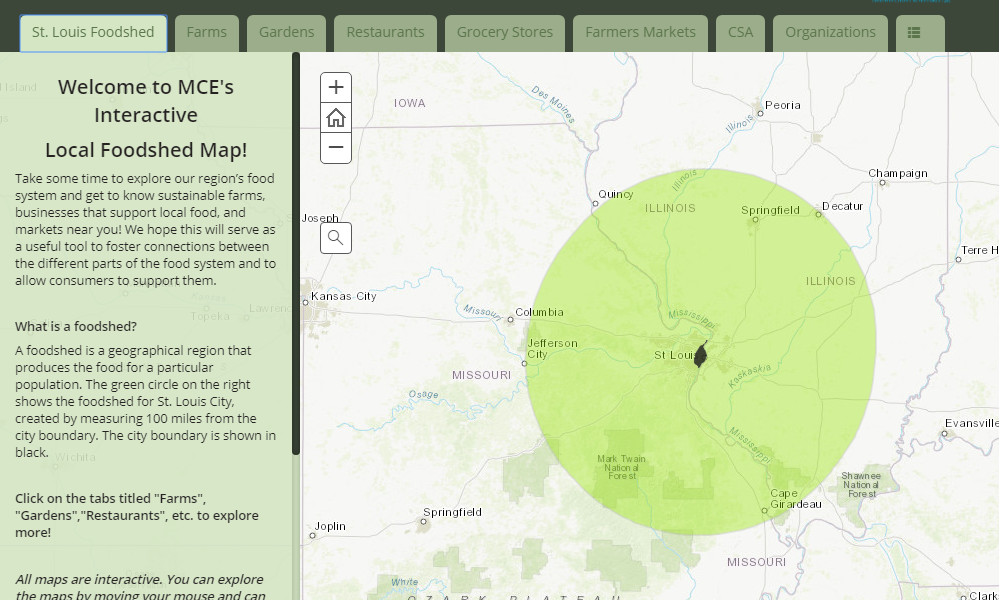In creating this map, we want to promote only those businesses that truly and regularly support local farmers. We’ve provided here sourcing connections that were listed by farmers, either on their farm websites or through Slow Food St. Louis’s Farm Directory.
How To Use This Map
We have plotted resources within the 150-mile radius of St. Louis, which we call the St. Louis Regional Foodshed and which is the geographical focus of MCE’s St. Louis Regional Food Study.
The Tabs: Click on different tabs like “Farms”, “Gardens”, etc. to view the different layers of the map. Everytime you click on a new tab the map changes what it is showing. To the right of a map is information on what is being shown, providing images, videos or links for more information.
The Map: Drag with your mouse to move around the map and use the “+” and “-” buttons to zoom in and out. Click on the search icon to search for a specific address. Click on the “overview map” tab to get an overview of what area you are looking at.
Definitions of Environmental Practices
We want to support farms that use truly sustainable methods. To learn more about the terms used in the descriptions of farming practices, browse this list of definitions. Unless otherwise specified, these definitions were provided in Slow Food St. Louis’s Farm Directory. We’ve also included the ways that our partners have defined “sustainable practices” for their own lists.
Animal Welfare Approved: This non-profit grants its certification to independently-owned family farms that raise their animals outdoors on pasture. Antibiotic use is allowed only for illness. Certification is not granted to producers who use growth hormones and requires animals be rendered insensible to pain prior to slaughter.
Antibiotic Free: No antibiotics were used over the animal’s lifetime. According to the journal Public Health Reports, “Evidence that antibiotic use in food animals can result in antibiotic-resistant infections in humans has existed for several decades. Associations between antibiotic use in food animals and the prevalence of antibiotic-resistant bacteria isolated from those animals have been detected in observational studies as well as in randomized trials.
Biodynamic: Emphasis is placed on the holistic development and interrelationships of the soil, plants and animals as a self-sustaining system.
Biological pesticides: According to the EPA’s Office of Pesticide Programs, “Biopesticides are certain types of pesticides derived from such natural materials as animals, plants, bacteria, and certain minerals. Biopesticides are usually inherently less toxic than conventional pesticides.”
Biointensive: A small-scale production system that fosters healthy soils, conserves space and requires low inputs, while maximizing yields and increasing sustainability and overall soil health.
Certified Humane Raised and Handled: Growth hormones are prohibited and animals are raised on a diet without antibiotics. Antibiotics can be used in the treatment of sick animals. Access to clean and sufficient food and water and a safe, healthful living environment is also required from birth through slaughter. Producers also must comply with environmental standards.
Certified Naturally Grown: Farmers do not use synthetic herbicides, pesticides, fertilizers, antibiotics, hormones, or genetically modified organisms. CNG livestock are raised mostly on pasture and with space for freedom of movement. Feed must be grown without synthetic inputs or genetically modified seed.
Community Supported Agriculture (CSA): A contract under which shareholders pay an upfront fee to the farmer who then, in return, provides a share of each week’s harvest during the growing season. Both partners share the risks and rewards of small-scale farming, from unpredictable weather to bumper crops.
Conventional: How most American farms have operated over the past 50-plus years. Commercial chemical, synthetic fertilizers, pesticides and herbicides are used.
Cover Cropping: According to the Midwest Cover Crops Council, “cover crops are plants seeded into agricultural fields, either within or outside of the regular growing season, with the primary purpose of improving or maintaining ecosystem quality.” Cover crops enhance biodiversity, create wildlife habitat, attract pollinators, reduce erosion, improve soil quality, retain nutrients, and break disease cycles.
Crop Rotation: According to the Agricultural Research Service, crop rotation is a pre-planned system of growing different crops in succession for better soil and farm management that also considers economic conditions. Crop rotation can increase crop productivity by enhancing soil quality, managing pests, and reducing soil erosion.
Free Range: (Poultry) Animals are allowed access to the outdoors. According to the National Chicken Council, “there’s no precise federal government definition of “free range,” so the U.S. Department of Agriculture (USDA) approves these label claims on a case-by-case basis. USDA generally permits the term to be used if chickens have access to the outdoors for at least some part of the day, whether the chickens choose to go outside or not.”
Genetically Modified Organisms (GMO): Plants and animals whose genetic material has been altered using genetic engineering techniques in a lab. This technology is highly controversial on ethical, environmental and food safety grounds.
Heirloom Varieties: Growing heirloom varietals helps to preserve genetic diversity by ensuring that these unique plant varieties do not become extinct. Heirloom seeds have been passed down for generations and are treasured for their unique and delicious flavors, textures and stories.
Heritage Breeds: Traditional animal breeds raised by farmers before industrial agriculture drastically reduced breed variety.
Hormone Free: Growth hormones are not used to force an animal to gain weight, increasing incidences of disease and leading to the routine prescription of antibiotics. Hormones are not permitted in chicken or hog production.
Integrated Pest Management (IPM): The practice of using pesticides strategically and sparingly, alongside other techniques like nurturing greater diversity. Growers use the most economical means causing the least possible hazard to people, property and the environment.
Intensive Rotational Grazing: The use of several pastures with one being grazed while the others are rested, allowing the vegetation to renew energy reserves, rebuild shoot systems, and deepen root systems.
Natural Soil Amendments: According to Mother Earth News, “Natural soil amendments are used for correcting specific major or minor nutrient deficiencies in [a] plot.” For example, farmers might apply nitrogen sources such as fish meal or potassium sources such as sea deposits to enhance nutrient balance.
No Till: An agricultural technique that minimizes or eliminates plowing, keeping soil disruption to a minimum. No Till farming increases the amount of water and organic matter (nutrients) in the soil and decreases erosion.
Occultation: A weeding technique in which farmers cover unused beds with tarps. According to the publication The Market Grower, occultation is “a very effective way of avoiding weed proliferation in the garden and diminishing weed pressure on subsequent crops. The explanation is simple: weeds germinate in the warm, moist conditions created by the tarp but are then killed by the absence of light.”
Pastured/Grass-Fed: Applies to cattle, poultry, and other herd animals. Animals eat pasture during the warm months and hay/silage during the colder months throughout their lives. Don’t be misled by grass-fed meat–these animals all start out eating grass.
“100% Grass-Fed and Finished” refers to the animals eating only grass, wild plants, dried hay, and silage throughout their lives.
“Grain finished” means animals ate forage (see above) until the final month(s) when they were “finished’ on grain.
“Grain supplemented” means the cows are fed a mixture of pasture grasses, hay and grain throughout their lives.
Permaculture: The design and creation of self-sustaining, agriculturally productive systems which have the diversity, stability and resilience of natural ecosystems. Permaculture design incorporates a diversity of species and interrelations between species, and allows for the continuous evolution that occurs in nature.
rbST Free: According to the Center for Food Safety, rbST (also known as rbGH) is a genetically engineered hormone that many U.S. dairy farmers inject in cows to boost milk production. “In cows treated with rbGH, significant health problems often develop, including a 50% inclrease in the risk of lameness (leg and hoof problems), over a 25% increase in the frequency of udder infections (mastitis), and serious animal reproductive probelms.” In addition, research has demonstrated that the “levels of a hormone called ‘insulin-like growth factor-1’ (IFG-1) are elevated in dairy products produced from cows treated with rbST” and that IFG-1 is “an important factor in the growth of cancers of the breast, prostrate, and colon.”
“Sustainable practices” according to Food Works: As listed in Food Works’s member directory.
“Sustainable practices” according to Illinois Stewardship Alliance: Farmers wishing to be members in Buy Fresh Buy Local–Central Illinois must agree to to the following statement in the application.
“I understand and meet the eligibility requirements stated on the reverse side of this application. I will uphold the integrity of the Buy Fresh Buy Local–Central Illinois purpose while I am a member and adhere to these guidelines. I agree to use my knowledge, skills, and land to grow high quality products that will be sold primarily in the Central Illinois region. I will displace the BFBL-CI graphics and agree to use them for the promotion of my farm and only on items that adhere to these eligibility requirements.”
Synthetic Herbicide- and Pesticide-Free: According to the EPA, synthetic pesticides are the most widespread method for pest-control. However, “[e]nvironmental and human health problems related to the use of synthetic pesticides have created an increasing pressure against their use.” For example, pesticides can “leach through the soil and enter the groundwater below.” In addition, pesticide residue on food may be consumed by humans. Similarly, the EPA also states that “herbicides are applied to soil or terrestrial vegetation, which can increase herbicides in groundwater dischage, atmospheric drift, and in runoff (storm or irrigation).”
Vermi-composting: According to the California Department of Resources Recycling and Recovery, vermi-composting is the practice of using worms to break down food scraps. The resulting material is a mix of worm castings and decomposed food scraps…Worms like to feed on slowly decomposing organic materials like fruit and vegetable scraps. Worms produce castings that are full of beneficial microbes and nutrients, which makes a great plant fertilizer. Worms are very efficient at breaking down food scraps and can eat over half their body weight in organic matter every day.
USDA Organic: To be certified “organic” by the USDA, farmers use sustainable growing practices, do not use synthetic drugs, synthetic fertilizers or synthetic pesticides, irradiation or genetic engineering, artificial growth regulators, antibiotics, food additives or human sewage sludge as fertilizer. Many farmers follow organic practices but choose not to be certified.
Looking for more maps related to food and agriculture? Check out these maps below:
Interactive CAFO Map of Missouri and CAFO Story Map
North St. Louis Food Access Map
 Policy and Agriculture Story Map
Policy and Agriculture Story Map
Sustainable Agriculture Story Map
Soil Story Map
Thank you to our Partners!
This map would not have been possible without our partners, Slow Food St. Louis, Illinois Stewardship Alliance, and Food Works, providing MCE with the names of the sustainable farms they work with, their farm practices, their product types, their contact information, and at which stores, farmers markets, and restaurants you can find their products. Greening Dining Alliance (GDA) also provided us with a few additional restaurants that GDA has certified as sourcing >15% of their ingredients locally during the growing season.
Other useful resources: The USDA Farmers Markets Directory. Farms that practice sustainable agriculture practices stated which farmers markets they sell to and that information is provided in the farmers markets’ information boxes.

